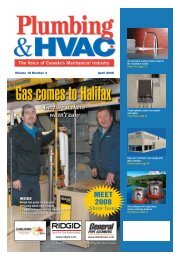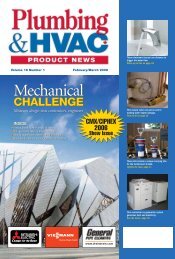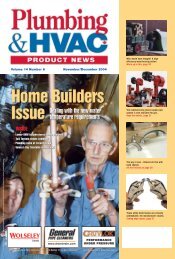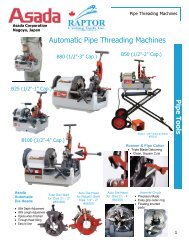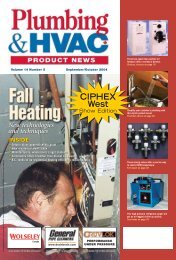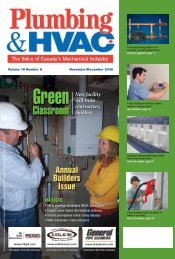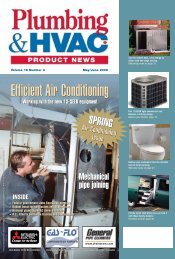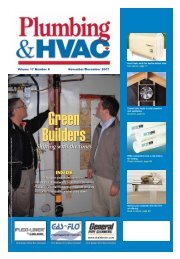CMX 2004 - Plumbing & HVAC
CMX 2004 - Plumbing & HVAC
CMX 2004 - Plumbing & HVAC
You also want an ePaper? Increase the reach of your titles
YUMPU automatically turns print PDFs into web optimized ePapers that Google loves.
Industry News<br />
Low flush revisited<br />
Test accuracy improved, results still poor<br />
By Simon Blake<br />
Ajoint Canadian/U.S. study on the<br />
flush performance and water-use<br />
of six-litre toilets goes to extreme<br />
lengths to ensure that the information is<br />
accurate. Unfortunately, the results<br />
weren’t much better for the manufacturers<br />
than in previous tests.<br />
Conducted by the Canadian Water<br />
and Wastewater Association (CWWA)<br />
on behalf of 19 municipalities in<br />
Canada and the U.S. along with the<br />
Canadian Mortgage and Housing<br />
Corporation (CMHC), the primary<br />
financial backer, and the B.C. Buildings<br />
Corporation, the $150,000 the test<br />
looked at over 80 popular low flush toilets.<br />
Of these, 44 were purchased off the<br />
shelf. The other 37 were supplied by<br />
manufacturers and tested separately.<br />
Municipalities that offer subsidies to<br />
home/building owners have long been<br />
concerned that flush performance tests<br />
outlined in the CSA B-45 standard<br />
don’t accurately reflect toilet performance,<br />
reported Duncan Ellison, CWWA<br />
executive director. “Municipalities were<br />
concerned that if they were to offer a<br />
75-dollar subsidy for installing a sixlitre<br />
toilet, that they should actually<br />
flush six litres.”<br />
Manufacturers criticized a study conducted<br />
two years ago, saying the breakfast<br />
cereal used to measure flush performance<br />
didn’t accurately imitate<br />
human waste.<br />
A test team lead by William Gauley,<br />
P. Eng., went to great lengths to get it<br />
right this time. Canadian tests were<br />
conducted at Veritec Consulting Inc. in<br />
Mississauga, Ont. The ‘Maximum Performance<br />
Test’ used a soybean-based<br />
paste developed with a density, moisture<br />
content, etc. very close to that of<br />
human waste.<br />
A British medical study determined<br />
that the average size of human waste<br />
(We’re trying to be as polite as possible<br />
here – ed) is 250 grams for a male and<br />
slightly less for a female. Therefore, the<br />
soybean paste was formed into stools<br />
measuring four inches long and just less<br />
than one inch in diameter. Four loosely<br />
crumpled balls of toilet paper were<br />
included in each test.<br />
All toilets were assembled, placed on<br />
a test stand and connected to a water<br />
supply. Tank water levels were set to the<br />
water line and flush volumes were<br />
recorded. Adjustments were made<br />
where required to ensure all samples<br />
flushed at the rated volume (typically<br />
six litres).<br />
However, approximately half the toilets<br />
tested failed to efficiently flush the<br />
benchmark 250 grams.<br />
The soybean ‘turds’ were loaded in<br />
50-gram increments until the toilets<br />
failed to efficiently flush. Of the 44 offthe-shelf<br />
models, 20 flushed less than<br />
250 grams, 13 flushed between 250 and<br />
500 and 11 models flushed over 500.<br />
Two models – one gravity operated and<br />
the other pressure assisted – flushed<br />
over 800 grams.<br />
All models tested achieved a minimum<br />
water exchange (change-out) rate<br />
of 98 per cent, even those toilets that<br />
cleared only 100 grams of solids, leading<br />
researchers to question the validity<br />
of this test to identify superior performing<br />
toilets.<br />
About one-third of the off-the-shelf<br />
models flushed more than six litres of water,<br />
with a high of 9.5 litres, and a low of 3.6.<br />
A number of models were tested with<br />
a standard (universal) replacement flapper.<br />
(This wasn’t performed on models<br />
where a standard flapper couldn’t be<br />
used.) More than 70 per cent showed a<br />
significant increase in water use, with<br />
the highest jumping to almost 16 litres<br />
per flush.<br />
The full test report, with names of<br />
manufacturers, toilet models and test<br />
results, is available on the CWWA web<br />
site at www.cwwa.ca.<br />
Randy, left, and Dave Bykowsky of Energy Saving Products Ltd., Edmonton, Alta.,<br />
hauled their 6000 hp nitro-methane burning drag racer to the AHR Expo and<br />
drew considerable interest for their high velocity heating/cooling equipment.<br />
Largest west coast show<br />
The recent AHR Expo set records for a<br />
west coast show in virtually every category.<br />
North America’s largest annual<br />
<strong>HVAC</strong>/R show took place at the<br />
Anaheim, Calif. Convention Centre<br />
Jan. 26-28.<br />
In total, 22,000 registered visitors<br />
(not including exhibitor personnel)<br />
viewed products from 1,652 exhibiting<br />
companies on 324,590 sq. ft. of exhibit<br />
space. Roughly 100 Canadian exhibitors<br />
participated. The event coincided<br />
with the ASHRAE technical sessions.<br />
The next AHR EXPO will take place in<br />
Orlando, Florida, Feb. 7-9, 2005.<br />
Ontario plumbers,<br />
builders dodge a bullet<br />
By Simon Blake<br />
The province of Ontario will allow<br />
acrylic tubs in buildings over 18<br />
metres or six stories, without requiring<br />
a fire sprinkler system.<br />
The Ontario Ministry of Municipal<br />
Affairs amended the Ontario Building<br />
Code, effective Feb. 20, to allow fixtures<br />
with a smoke developed classification<br />
up to 500 – which acrylic fixtures meet<br />
– if they are ‘installed in buildings used<br />
for residential occupancies, and the<br />
plumbing fixture is located in a room<br />
where the wall surfaces have a smoke<br />
developed classification not more than<br />
200.’ Or in other words, as long as the<br />
building materials surrounding the fixtures<br />
have a smoke developed classification<br />
of less than 200, the fixtures themselves<br />
can exceed that level.<br />
A ruling last fall by a building inspector<br />
in Burlington, Ont. sent panic<br />
through the Ontario construction<br />
industry by invoking a seldomenforced<br />
section of the Ontario Building<br />
Code that barred the use of acrylic<br />
tubs in high-rise buildings because they<br />
couldn’t meet the minimum requirements<br />
for smoke developed in the event<br />
of a fire. Thousands of acrylic soaker<br />
tubs have been installed across Ontario<br />
over the past ten years.<br />
The situation became even more<br />
critical on Feb. 9 when the City of<br />
Toronto sent a notice to building permit<br />
applicants, the design community<br />
and builders that Ontario Building<br />
Code Article 3.1.13.7, which prohibits a<br />
smoke-developed level over 300, would<br />
be enforced. While not prohibiting<br />
occupancy, the city announced that it<br />
would issue deficiency notices where<br />
acrylic fixtures were installed.<br />
The Canadian Industry of <strong>Plumbing</strong><br />
and Heating, along with the <strong>Plumbing</strong><br />
Industry Advisory Council, lobbied the<br />
ministry to amend the code. Had they<br />
not been successful, builders would have<br />
had to revert to steel tubs. And there were<br />
also liability concerns over the thousands<br />
of acrylic tubs already installed.<br />
Ontario is the only province that<br />
doesn’t require sprinkler systems in residential<br />
high-rise buildings over six<br />
stories.<br />
In Brief<br />
RMC wants cylinders<br />
40 per cent full<br />
Refrigerant Management Canada<br />
(RMC) advises contractors that<br />
refrigerant cylinders must be at<br />
least 40 per cent full to be accepted<br />
by the RMC refrigerant collection<br />
program for disposal. RMC<br />
participating wholesale staff are<br />
being asked to weigh cylinders<br />
when they come in to ensure the<br />
minimum capacity is met. RMC<br />
warns that if under-filled cylinders<br />
continue to be turned in, collection<br />
costs will rise and the current<br />
$1/kg levy may have to be<br />
increased. For more information,<br />
contact RMC at 1-866-622-0209.<br />
RMC reports CFC stocks<br />
Speaking of refrigerants,<br />
Refrigerant Management Canada<br />
also reports a mid-2003 survey of<br />
refrigerant stocks that estimates<br />
there are a total of 820,000 kilograms<br />
of CFC R-502 still held by<br />
various sources and end-users. The<br />
survey also estimated 192,000 kg<br />
of CFC R-12 is still in inventory<br />
across Canada.<br />
Furnace rebate<br />
program extended<br />
Natural Resources Canada has<br />
extended the deadline allowing<br />
furnaces to be installed under the<br />
EnerGuide for Houses (EGH) retrofit/rebate<br />
program where an audit<br />
of the home hasn’t yet been done.<br />
The pre-audit exemption has been<br />
extended to March 31 from the<br />
original expiry date of Feb. 12.<br />
The program rewards homeowners<br />
based on the efficiency of the<br />
equipment they install. An<br />
EnerGuide for Houses energy efficiency<br />
audit must be done on the<br />
home. Rebates are based on the<br />
amount of improvement in efficiency.<br />
Contact HRAI at 1-800-<br />
267-2231 or go to www.hrai.ca.<br />
Sales by wholesalers up<br />
Sales by Canada’s plumbing, heating<br />
and cooling wholesalers topped<br />
out at a record $3.5 billion for<br />
2003, reports the Canadian<br />
Institute of <strong>Plumbing</strong> and Heating<br />
(CIPH). This reflects a seven per<br />
cent increase over 2002. All<br />
regions were up with the Atlantic<br />
provinces up 15 per cent, B.C. up<br />
13 per cent, the West up 10 per<br />
cent, Quebec up eight per cent<br />
and Ontario up four per cent,<br />
reports Ralph Suppa, CIPH<br />
president and general manager.<br />
Honeywell thermostat<br />
patent challenged<br />
Honeywell’s monopoly on the<br />
round thermostat design is being<br />
challenged. A U.S. District Court<br />
(Continued on page 9)<br />
www.plumbingandhvac.ca March/April <strong>2004</strong> – <strong>Plumbing</strong> & <strong>HVAC</strong> Product News 7




